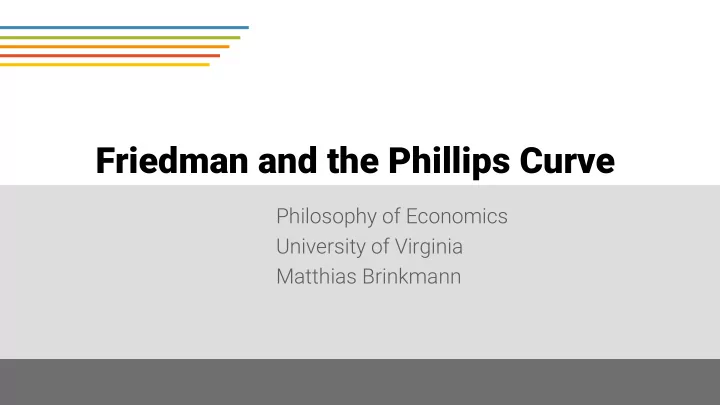

Friedman and the Phillips Curve Philosophy of Economics University of Virginia Matthias Brinkmann
Contents 1. The Phillips Curve 2. Friedman’s Critique 3. Monetarism 4. Methodological Reflections 5. Some Empirical Data Friedman and the Phillips Curve 2
A Famous Curve • Phillips 1958 plotted unemployment against changes in wages for British data: the two seemed to stand in a negative relationship • Samuelsson/Solow 1960 applied the idea to American data, and (seemed to) interpret this as a policy trade-off: policy makers can choose higher inflation to achieve lower unemployment Phillips 1958, p. 294 Friedman and the Phillips Curve 3
Basic Phillips Curve Inflation ( π ) One potential causal story: Inflation up Unemployment down In the short run, wages are fixed (“sticky”) If prices rise, companies make more profit, as their (wage) costs stay the same This gives them an incentive to hire more workers, thus diminishing unemployment π 2 π 1 Unemployment ( U ) U 1 U 2 Friedman and the Phillips Curve 4
Contents 1. The Phillips Curve 2. Friedman’s Critique 3. Monetarism 4. Methodological Reflections 5. Some Empirical Data Friedman and the Phillips Curve 5
Two Main Claims • There is a “natural” rate of unemployment “ground out by the Walrasian system of general equilibrium equations”, independent of monetary policy ( independence hypothesis ) Blanchard: this can be easily generalized to economic output The principled idea is that there is a long-term natural growth rate, real interest rate, unemployment rate (etc.) which are determined by “real” economic factors (i.e., independent from monetary factors) • Monetary policy cannot sustain unemployment rates below the natural rate without accelerating inflation ( accelerationist hypothesis ) (After Blanchard , Olivier. “Should We Reject the Natural Rate Hypothesis?” Journal of Economic Perspectives 32, no. 1 (2018): 97 – 120.) Friedman and the Phillips Curve 6
Friedman’s Critique • Friedman 1968 (lecture given December 1967): it is not possible to exploit the Phillips Curve in the long run, as workers will adjust expectations • Workers must suffer from money illusion : they must mistake their nominal wages for real wages • If workers expect inflation, they will adjust their nominal wage demands upwards • Policy makers cannot push unemployment below the “ natural rate of unemployment ” in the long run! Friedman and the Phillips Curve 7
A Simplified Account Inflation ( π ) “natural” rate of unemployment π 2 π 1 Unemployment ( U ) U 1 = U n U 2 Friedman and the Phillips Curve 8
Disaster for the Phillips Curve (?) • In the late 1960s, both inflation and unemployment spiked • Rising inflation seemed to have lost its power as a policy instrument! Source: Gordon 2011, p. 15 Friedman and the Phillips Curve 9
Disaster for the Phillips Curve (?) Source: Gordon 2011, 20 Friedman and the Phillips Curve 10
Contents 1. The Phillips Curve 2. Friedman’s Critique 3. Monetarism 4. Methodological Reflections 5. Some Empirical Data Friedman and the Phillips Curve 11
Laidler (1981): Features of Monetarism 1. A ‘quantity theory’ approach to macroeconomic analysis in two distinct senses: (a) that used by Milton Friedman (1956) to describe a theory of the demand for money, and (b) the more traditional sense of a view that fluctuations in the quantity of money are the dominant cause of fluctuations in money income. 2. The analysis of the division of money income fluctuations between the price level and real income in terms of an expectations-augmented Phillips curve whose structure rules out an economically significant longrun inverse trade-off between the variables. 3. A monetary approach to balance-of-payments and exchange-rate theory. 4. (a) Antipathy to activist stabilisation policy, either monetary or fiscal, and to wage and price controls, and (b) support for long-run monetary policy ‘rules’ or at least prestated ‘targets’, cast in terms of the behaviour of some monetary aggregate rather than of the level of interest rates. Friedman and the Phillips Curve 12
Keynes on Early Monetarism Now ‘in the long run’ this [way of summarizing the quantity theory: that a doubling of the money stock doubles the price level] is probably true. […] But this long run is a misleading guide to current affairs. In the long run we are all dead . Economists set themselves too easy, too useless a task if in tempestuous seasons they can only tell us that when the storm is long past the ocean is flat again. (Keynes, quoted after De Long 2000, 85-6) Friedman and the Phillips Curve 13
Contents 1. The Phillips Curve 2. Friedman’s Critique 3. Monetarism 4. Methodological Reflections 5. Some Empirical Data Friedman and the Phillips Curve 14
Questions • What methodology does Friedman follow in his paper? • How does monetarism/Friedman’s methodology fare from the point of view of Popper’s falsificationism? Lakatos ’ methodology of research programmes? his own methodological views? • How much of Friedman’s proposal/monetarism has survived? Friedman and the Phillips Curve 15
Contents 1. The Phillips Curve 2. Friedman’s Critique 3. Monetarism 4. Methodological Reflections 5. Some Empirical Data Friedman and the Phillips Curve 16
Blanchard, “Back to the 60s?” Results from Blanchard, The US Phillips Curve: Back to the 60s? : • Low unemployment still pushes inflation up; high unemployment pushes it down. […] • Inflation expectations, however, have become steadily more anchored, leading to a relation between the unemployment rate and the level of inflation rather than the change in inflation. […] • The slope of the Phillips curve, i.e., the effect of the unemployment rate on inflation given expected inflation, has substantially declined. […] • The standard error of the residual in the relation is large, especially in comparison to the low level of inflation. https://piie.com/publications/pb/pb16-1.pdf Friedman and the Phillips Curve 17
Broken Phillips Curve? https://www.pimco.com/en-us/insights/viewpoints/viewpoints/broken-phillips-curve-a-symptom-of-lower-us- inflation-expectations/ Friedman and the Phillips Curve 18
Unemployment Mandate of the Fed https://www.federalreserve.gov/faqs/economy_14424.htm Friedman and the Phillips Curve 19
Recommend
More recommend